
Dudleya virens, the green liveforever or bright green dudleya, is an uncommon species of perennial, succulent plant in the family Crassulaceae, native to several coastal southern California and Baja California locations.

Dudleya, commonly known as liveforevers is a genus of rosette-forming succulent plants in the stonecrop family, Crassulaceae, consisting of about 68 taxa in southwestern North America and Guadalupe Island. The species come in many forms, with some large and evergreen, others geophytic and deciduous. Yet, despite their dramatic variations in appearance, most species readily hybridize. The flowers of Dudleya have parts numbered in fives, with the petals arranged in tubular, star-shaped, and bell-shaped forms and, when fruiting, are filled with tiny, ovoid-crescent-shaped seeds.

Dudleya abramsiisubsp. setchellii, known by common name as the Santa Clara Valley dudleya or Santa Clara Valley liveforever, is a member of the Dudleya genus of succulent perennials, members of the family Crassulaceae. The Santa Clara Valley dudleya, endemic to the Santa Clara Valley region in the southern San Francisco Bay Area, was listed on 3 February 1995, as an endangered species. It is considered to be a subspecies of Dudleya abramsii, but its taxonomic status is still unclear. Its closest relative is Dudleya cymosa subsp. paniculata, which is a morphologically similar sister taxon.

Dudleya candelabrum is a species of succulent plant known by the common names candleholder liveforever or candleholder dudleya. Endemic to California, this species grows wild only on the northern Channel Islands, where it is found in open rocky places and north-facing slopes. It is characterized by thin, spade-shaped green leaves and an inflorescence covered in long, reflexed bracts, with pale yellow flowers. It has been threatened by poachers shipping plants to South Korea.
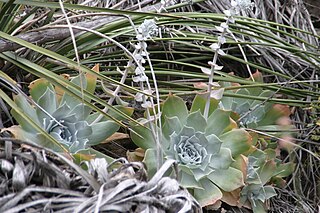
Dudleya pulverulenta is a species of perennial succulent plant known by the common names chalk lettuce, chalk dudleya, and chalk liveforever. It is one of the largest Dudleya, with a silvery, waxy rosette that may greatly contrast with its habitat. It is also regarded as one of the most distinctive members of the Dudleya, with the most advanced inflorescence in the genus, consisting of pendant, hummingbird pollinated flowers, the longest corolla, and the highest nectar output, along with the largest range of all the Dudleya, over 1,000 kilometres (620 mi), being found from southern Monterey County in California to the Sierra de San Borja in southern Baja California.

Dudleya greenei is a perennial species of succulent plant known by the common names Greene's liveforever, or Greene's dudleya. It is endemic to the Channel Islands of California, where it grows along the cliffs of four of the eight islands. It is a highly variable plant, presenting with multiple forms and varying levels of ploidy. Taxonomically, this species is an insular segregate of Dudleya caespitosa, and was placed as a stopgap taxon by Reid Moran in his 1951 thesis on the genus. It is characterized by white or green leaf rosettes, loomed over by inflorescences bearing pale yellow to white flowers. It is a member of the subgenus Dudleya, as it cannot be propagated from leaf cuttings, does not grow from a corm, and has tight petals.
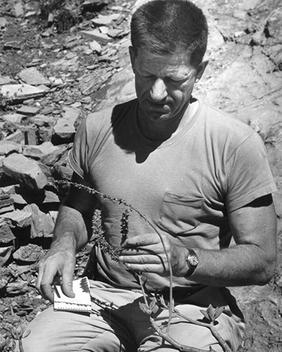
Reid Venable Moran was an American botanist and the curator of botany at the San Diego Natural History Museum from 1957 to 1982.

Dudleya attenuata is a species of perennial succulent plant known by the common name taper-tip liveforever, native to Baja California and a small portion of California. A rosette-forming leaf succulent, it has narrow pencil shaped leaves that can often be found covered in a white epicuticular wax. The thin, sprawling stems branch to form the clusters of rosettes, with plants creating a "clump" up to 40 cm wide. The small flowers are white or yellow, with 5 spreading petals. It is a diverse, variable species that extends from the southernmost coast of San Diego County to an area slightly north of the Vizcaino Desert, hybridizing with many other species of Dudleya in its range. Some plants with white or pinkish flowers were referred to as Orcutt's liveforever, referring to a former subspecies split on the basis of the flower color.

Dudleya ingens is a species of perennial succulent plant in the family Crassulaceae commonly known as the rock liveforever or Baja liveforever. A relatively large member of the genus Dudleya, this species has long green succulent leaves, and in April to June is characterized by pale yellow to white pink-tinged flowers topping tall, reddish inflorescences. It has a stem clothed densely with old, leathery leaves, and the inflorescence may be nodding, with the floral branches bearing the flowers tending to unfurl like the fronds of a fern. It is similar in appearance to Dudleya brittonii, but differs in range and chromosome number. This species is endemic to the state of Baja California in Mexico, being found from Santo Tomás to the southern coast of the state.

Dudleya hendrixii is a rare succulent plant known by the common name Hendrix's liveforever. It was discovered in late 2016 by researchers from San Diego State University and University of California, Santa Cruz.
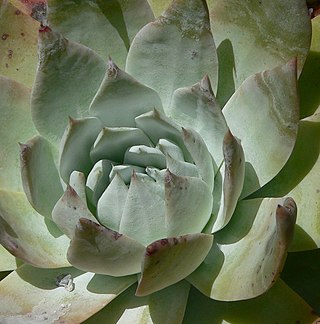
Dudleya anthonyi, known by the common name San Quintín liveforever, is a succulent plant endemic to the San Quintín volcanic field, located on Isla San Martín and the adjacent mainland bay of Bahia San Quintín, within Baja California.
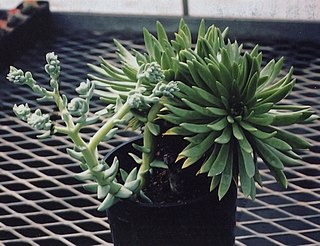
Dudleya guadalupensis is a very rare species of succulent perennial plant in the family Crassulaceae commonly known as the Guadalupe liveforever. It is a rosette-forming leaf succulent, with foliage that is variously colored light green, green, and a waxy white. It is characterized by dense leaves that fold over the center in dormancy, a curving, sinuous flower stalk, and white, cup-shaped flowers. It is endemic to the rocks and islets off of Guadalupe Island, an isolated volcanic island in the Pacific Ocean located 241 kilometers off of the coast of Baja California.

Dudleya anomala is a rare species of succulent plant in the family Crassulaceae commonly known as the Todos Santos liveforever. With a dense, cushion-forming habit, this leaf succulent is characterized by elongated stems, slightly sticky leaves, and bell-shaped flowers with white, spreading petals. This species is native to Baja California, Mexico, and is found primarily on islands and one coastal locality.

Dudleya gatesii, known by the common name as Gates'liveforever, is a species of perennial succulent plant in the family Crassulaceae. It is native to the central desert of the Baja California peninsula, found growing along dry and rocky outcroppings. It is characterized by red inflorescences topped with white flowers, bracts that are often reflexed downwards, and a rosette of dark-green leaves turning reddish.

Dudleya pachyphytum is an insular succulent plant known by the common name Cedros Island liveforever. It is a member of the genus Dudleya, in the family Crassulaceae. Characterized by thick, blunt leaves covered in a white, powdery wax and adorned by white flowers in bloom, it is regarded as one of the most attractive and charismatic members of its genus. It is endemic to the foggy northern end of Mexico's Cedros Island, occupying an ecological niche shared with the Cedros Island Pine.
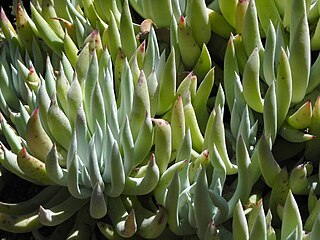
Dudleya albiflora, known by the common name white-flower liveforever, is a species of succulent perennial plant in the family Crassulaceae. It is native to the Baja California Peninsula. This species represents numerous populations with varying chromosome numbers scattered around the peninsula, but all share broad, common morphological traits such as white flowers and narrow leaves.
Eriogonum molle, known by common name as the Cedros soft buckwheat, is a species of wild buckwheat endemic to Cedros Island, Mexico.
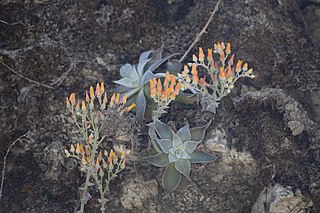
Dudleya cymosasubsp. pumila, most commonly known as the low canyon dudleya, chalky canyon dudleya or California live-forever, is a species of perennial succulent plant. It has diamond to spoon shaped leaves, sometimes coated with a fine white powder, and in May through July, bright red, orange or yellow flowers adorn the short inflorescence. A leaf succulent primarily found growing in rocky cliffs and slopes, it is endemic to California, and grows in the Transverse Ranges and South Coast Ranges, with some outlying populations. A variable plant, in some localities it is difficult to distinguish from other plants in the genus.

Dudleya saxosasubsp. aloides is a species of perennial succulent plant in the family Crassulaceae known by the common names desert dudleya or desert savior. It is a rosette-forming species widely distributed throughout the Peninsular Ranges and desert mountains of California in the United States. It is characterized by bright-yellow or greenish-yellow flowers, and can be found in shaded crevices and slopes. Plants in western half of the range may grade into Dudleya lanceolata.
Dudleya virens subsp. extima is a subspecies of succulent plant in the family Crassulaceae commonly known as the Guadalupe green liveforever. It is a rosette-forming leaf succulent, with both green and white waxy foliage. It has white flowers with spreading petals that bloom from May to June. It is a somewhat small plant, continuing a southward trend of decreasing size relative to other Dudleya virens subspecies. This plant is endemic to Guadalupe Island in the eastern Pacific Ocean, which is 241 kilometers off of the Baja California coast. It is very rare, with this plant only surviving on sheer cliff faces and canyons, out of the reach of the former feral goat population rampant on the island. It closely resembles a miniature version of Dudleya virens subsp. virens, but it may be more nearly related to the local Dudleya guadalupensis.


















